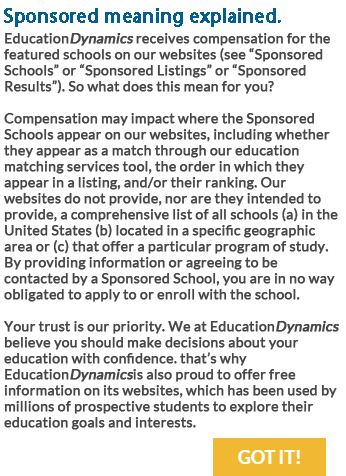Best Online Associate Degree Program
An accredited online associate degree could be right for anyone — including high school graduates, career changers, adult learners, stay-at-home moms and dads and even those seeking college education because of their love of learning. Associate degree programs may provide students a way to quickly prepare for a career, generally in as little as two years at a vocational school or community college. According to the Lumina Foundation, which has a mission of promoting higher education among adults, specifically through completion of associate degree programs, the 21st-century workplace is one where more skilled, talented and qualified employees are needed.By 2020, 30 percent of job openings are likely to require to an associate degree or some college education beyond high school, reports a Georgetown University study on job growth and education requirements.
Interestingly, a 2017 report from the Bureau of Labor Statistics (BLS) shows that, since 2012, people with an associate degree or some type of college education made up the largest segment of the workforce.
Types of Online Associate Degree Programs
In general, there are two types of associate degrees. These are occupational degree programs, which educate students in a specific field, and transfer degree programs, which can be used for to later complete a four-year program. How do you know which one is right for you? Take a closer look at the descriptions below.
- Occupational degree programs often are available in fields such as allied health, automation, computer science and technology, the paralegal field and graphic design. Online associate degree programs can help students to prepare for a career in a specific area, such as veterinary technology or phlebotomy. Generally, the education a student obtains in an online associate degree program is the maximum training needed for the field, and any advancement comes from completion of a higher degree in a related field.
- Transfer degree programs allow you to complete the first two years of a degree program at a community college and then to transfer those credits to another place, such as a university. Some community colleges even offer 2+2 degree programs, which are established transfer degrees programs with other schools. Transfer degree programs may be available in areas such as accounting, business, criminal justice, general studies, history and sociology.
Southern New Hampshire University
- Some of the nation’s most affordable tuition rates, from a private, nonprofit, NEASC accredited university
- Qualified students with 2.5 GPA and up may receive up to $20K in grants & scholarships
- Multiple term start dates throughout the year. 24/7 online classroom access
- Offering over 200 online degree programs
Is an Online Associate Degree Worth It?
It’s true that technology is driving the need for more educated workers — but, on the flip side, automation is replacing jobs held by less-skilled employees. Job security is one benefit that can come from an associate degree education, but higher pay could be a result, too.
Higher pay: The BLS reports that median weekly earnings for individuals with an associate degree is $836, but median pay is only $774 for those with some college education and no degree and $712 for those with just a high school diploma. This difference in earnings can certainly add up over a lifetime, but the Lumina Foundation reports there are other benefits as well to a college education. These can include:
- More likelihood of greater happiness
- Less incidence of poverty
- Greater likelihood of a retirement plan through an employer
- Longer life expectancy
- Smaller chance of unemployment
20 Best Online Associate Degree Programs 2019-20
Find the best online colleges for associate degrees based on factors that are important to you, as an online student. These include average tuition, average financial aid students receive, number of programs offered online, and many more. Be sure to take a look at our methodology at the bottom of the page.
https://www.calbaptist.edu
https://www.nu.edu
https://www.cui.edu
https://www.deltacollege.edu/
https://www.csueastbay.edu
https://www.apu.edu
https://www.ivc.edu
https://www.sdsu.edu
https://www.csuchico.edu
https://www.fullerton.edu
How Does an Online Associate Program Work?
An online associate degree program can provide the same opportunities as a campus-based associate program. Schools generally use the exact same syllabi and curriculum in both formats. There also are variations in the type of online programs available. These include:
Fully online associates degree programs can deliver content completely online, using platforms such as Canvas, Blackboard and others. Hybrid programs typically combine both online and campus-based learning, requiring students to be at school for a specific number of courses or to complete some components of their degree program at the site.
These two terms are just fancy words for whether or not students participate in real-time learning. Asynchronous simply means students can complete assignments, tasks and projects at their own pace (while still meeting deadlines) while synchronous learning can require students to be online at specific times to participate in live videos, live streaming or live chat.
Online associate degree programs typically take two years to complete, although some programs can be completed in an accelerated time frame, even as quickly as 18 months. Conversely, working parents or adults with other commitments may be able to take more time to complete an associate degree program. Some online associate degree programs may be available in more flexible formats, such as an eight-week program.
Associate degree programs typically require students to submit a transcript from their high school or have proof of a GED, as well as pay an application fee and submit scores from the SAT or another placement test.
Students may be able to pay or partially pay for college, through the use of scholarships or grants, which do not need to be repaid. Additional options to help with the costs of an online associate degree program include using federal loans, federal grants or work-study options.
Most Popular Associate Degrees to Earn Online
We’ve crafted this ranking of the most popular associate degrees based on the number of online associate degrees conferred, as well as median salary and employment projections related to the degree. This ranking is based on data provided by the Integrated Postsecondary Education Data System and the Bureau of Labor Statistics.
Popular Programs of Study | Median Salary | Projected Employment |
|---|---|---|
| Dental Hygiene/Hygienist | $74,820 | 746,400 |
| Medical Radiologic Technology/Science - Radiation Therapist | $70,925 | 755,100 |
| Computer Programming/Programmer, General | $66,100 | 1,596,000 |
| Computer Science | $66,100 | 1,995,000 |
| Radiologic Technology/Science - Radiographer | $59,520 | 921,600 |
| Web Page, Digital/Multimedia and Information Resources Design | $69,430 | 552,600 |
| Computer Systems Networking and Telecommunications | $62,770 | 859,200 |
| Electrical, Electronic and Communications Engineering Technology/Technician. | $64,330 | 419,400 |
| Computer and Information Systems Security/Information Assurance. | $62,770 | 859,200 |
| Network and System Administration/Administrator. | $62,770 | 644,400 |
Integrated Postsecondary Education Data System (IPEDS) 2017-18, National Center for Education Statistics
Fastest-Growing Occupations that Require an Associate Degree
Fastest-Growing Occupations | Annual Median Wage | Job Growth |
|---|---|---|
| Occupational Therapy Assistants | $61,510 | 33% |
| Physical Therapist Assistants | $58,790 | 27% |
| Respiratory Therapists | $61,330 | 21% |
| Diagnostic Medical Sonographers | $74,320 | 20% |
| Web Developers and Digital Interface Designers | $73,760 | 13% |
| Paralegals and Legal Assistants | $51,740 | 12% |
| Magnetic Resonance Imaging Technologists | $73,410 | 11% |
| Dental Hygienists | $76,220 | 11% |
| Radiologic Technologists and Technicians | $60,510 | 9% |
| Computer Network Support Specialists | $63,460 | 6% |
Highest-Paying Associate Degrees
Using data combined from the National Center for Education Statistics and the Bureau of Labor Statistic, this list of the highest-paying associate degrees can guide prospective students to choosing programs that may yield higher incomes compared to other associate degree programs. We have also taken into consideration other factors like number of colleges offering the degree online, projected growth rate of all jobs matched to each major, and more. Take a look at our methodology to see all the factors.
Explore Online Degree Programs
You may still be wondering if an accredited online associate degree program is right for you or what area you should study — vet tech training, or graphic design, or nursing education, for example. The buttons on this page can provide you with more opportunities to explore different fields. Just click on one or several links to learn more about associate degree programs in art, criminal justice, education, healthcare and other areas.
Methodology:
Methodology for Best Colleges Offering Online Associate Degrees
Requirements:
- Offer a degree or certificate program in that subject, either in an online or hybrid format
- Have at least 1% of students attending some form of distance education
- Have awarded at least one degree or certificate in that subject in 2015-16
- Have reported data for all 19 ranking variables listed below
We ranked 879 colleges and universities in the United States on 19 criteria, using 2016-17 data from the National Center for Education Statistics:
- Associate Program prominence, based on how many of the degrees and certificates awarded in 2016-2017 were in this particular subject
- Ratio of undergraduate students participating fully or partially in DE to Total Enrollment
- Average in-state tuition for undergraduates
- Retention rate
- Percent of undergraduate students awarded federal, state, local, institutional or other sources of grant aid
- Average amount of federal, state, local, institutional, or other sources of grant aid awarded to undergraduate students
- Student-to-faculty ratio
- Number of programs offered via distance education at the associate degree level
- Total electronic library collections, including digital books, databases, and media
- The availability of any tuition plans: Payment
- The availability of any tuition plans: Guaranteed
- The availability of any tuition plans: Prepaid
- The availability of any tuition plans: Other
- Services: Academic/Career
- Services: Placement for Completers
- Credit offerings: Dual
- Credit offerings: Life
- Credit offerings: AP
- Credit offerings: Military
Methodology for Most Popular Associate Degrees to Earn Online
For this analysis, we ranked 104 online associate degrees. To be included in the ranking, each major had to:
- Match to a corresponding code in the Classification of Instructional Programs
- Be offered online at the associate level at five or more institutions
We scored each major on the following data points, using a 10-point scale and the weights specified:
- Number of conferred associate degrees in all schools nationally, IPEDS, 2016-17
- Total number of jobs projected in 10 years of all occupations matched to the major, Bureau of Labor Statistics, 2016-26
- Annual median wage of each occupation matched to the major, Bureau of Labor Statistics, 2017
Methodology for Fastest-Growing Occupations with an Associate Degree
For this analysis, we ranked 63 occupations using data provided by the Bureau of Labor Statistics associated with a doctoral degree on the following variables:
- Annual Median Wage
- Employment Number
- Employment Change Percent
Methodology for Highest-Paying Associate Degrees to Earn Online
For this analysis, we ranked 86 online associate degrees. To be included in the ranking, each major had to:
- Match to a corresponding code in the Classification of Instructional Programs
- Be offered online at the associate level at five or more institutions
We scored each major on the following data points, using a 10-point scale and the weights specified:
- Annual median salary of each occupation matched to the major, Bureau of Labor Statistics, 2017
- Annual 25th percentile wage of each occupation matched to the major, Bureau of Labor Statistics, 2017
- No. of schools offering this degree online at the associate level, National Center for Education Statistics, 2016-17
- Average projected growth rate of all jobs matched to each major, Bureau of Labor Statistics, 2016-26
- Total number of jobs projected in 10 years of all occupations matched to the major, Bureau of Labor Statistics, 2016-26
Methodology Sources
- Integrated Postsecondary Education Data System (IPEDS) 2017-18, National Center for Education Statistics, http://nces.ed.gov/ipeds/
- 2017 Occupational Employment Statistics and 2016-26 Employment Projections, Bureau of Labor Statistics, BLS.gov
- 2017 Occupational Employment Statistics and 2016-26 Employment Projections, Bureau of Labor Statistics, BLS.gov; 2016-26 State Occupational Projections, Projections Central, projectionscentral.com
- Integrated Postsecondary Education Data System (IPEDS) 2016-17, National Center for Education Statistics, http://nces.ed.gov/ipeds/
Article Sources:
- Applying for Admission: Certificate or Associate Degree Programs, University of Alaska Fairbanks, Accessed October 2018, https://catalog.uaf.edu/getting-started/admission-certificate-associate/
- Asynchronous Learning, University of Michigan, Accessed October 2018, http://umich.edu/~elements/asyLearn/learning.htm
- “It’s not just the money,” Philip Trostel, Lumina Foundation, Accessed October 2018, https://www.luminafoundation.org/files/resources/its-not-just-the-money.pdf
- Measuring the Value of Education, Bureau of Labor Statistics, Accessed October 2018, https://www.bls.gov/careeroutlook/2018/data-on-display/education-pays.htm
- Postsecondary learning builds the talent that helps us rise, Lumina Foundation, 2016, https://www.luminafoundation.org/files/publications/stronger_nation/2016/A_Stronger_Nation-2016-National.pdf
- “Profile of the Labor Force by Educational Attainment,” Vernon Brundage, Jr., U.S. Bureau of Labor Statistics, August 2017, https://www.bls.gov/spotlight/2017/educational-attainment-of-the-labor-force/pdf/educational-attainment-of-the-labor-force.pdf
- Recovery, Job Growth and Education Requirements through 2020, Executive Summary, Center on Education and the Workforce, Georgetown University, https://cew.georgetown.edu/wp-content/uploads/2014/11/Recovery2020.ES_.Web_.pdf, accessed February 2019


